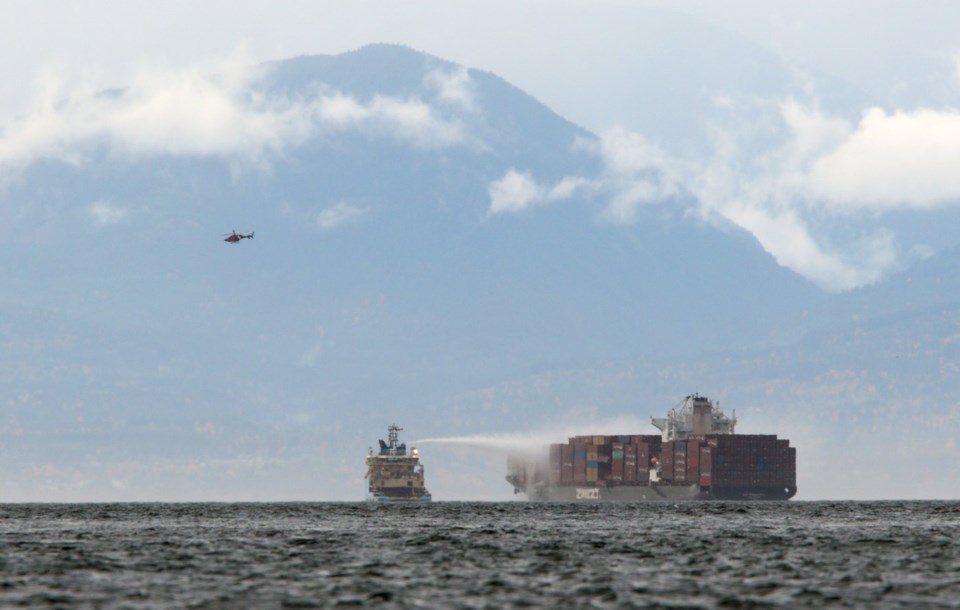Canada needs to act promptly to require emergency-response plans for vessels, says the Transportation Safety Board, in the wake of an investigation into a container ship that rolled and lost more than 100 containers off the Island’s west coast three years ago.
After losing cargo about 50 kilometres south of Ucluelet, the Zim Kingston made its way to Constance Bay off Victoria, where a fire broke out in a container that contained potassium amyl xanthate, then spread to other cargo, burning for five days.
The Zim Kingston incident is just the latest maritime emergency highlighting the “ever-present risk to people, property and the environment” such incidents pose, Kathy Fox told a news conference in Vancouver on Wednesday.
“It’s not a matter of if but when a similar incident will occur.
“And the question is: Will Canada be prepared for it?”
Transport Canada is in the midst of developing regulations to strengthen preparedness requirements for the industry — including requiring vessels to have arrangements for firefighting and salvage services, and creating a specialist position who could work with the federal departments and others to manage an incident — but they are not expected to be in place until 2028.
“We know from past experience that developing regulations could take substantially longer than anticipated but there’s no need for that,” Fox said.
“It’s a matter of priorities and surely it can be done much quicker.”
The board also cited the need for comprehensive guidance to manage the risk of dangerous “parametric” rolling, which was experienced by the Zim Kingston, which tipped 36 degrees.
The risk of this type of rolling could have been identified by using guidance materials that are available to industry but were not on board the Zim Kingston, Fox said.
The Zim Kingston left South Korea on Oct. 6, 2021 loaded with nearly 2,000 containers carrying both dangerous goods and consumer products, and bound for the Deltaport container terminal in Delta.
It arrived three days later, but the master was told there were no anchorages available.
He decided to hold the vessel offshore, outside Juan de Fuca Strait. But when a storm rolled in, the Zim Kingston rolled from side-to-side four times, sending 109 containers, or 11 per cent of the vessel’s deck cargo, overboard, said Etienne Seguin-Bertrand, senior investigator with the Transportation Safety Board.
That kind of rolling happens when sea conditions, such as wave height, length and direction, combine with other factors specific to a vessel, such as stability and speed.
“When those factors interact in a precise way, sudden dangerous rolling motions are generated,” he said.
The TSB report says there needs to be a focus on monitoring for the conditions that give rise to the rolling so preventive measures can be taken.
“Not only is it difficult to predict exactly when a parametric rolling event will occur, but once extreme rolling starts, it may not be possible to stop the dangerous motions before negative consequences occur, such as container loss,” the report says.
In the case of the Zim Kingston, the owner had not developed procedures to manage the risk of such rolling, the report says. “As a result, this risk was not being effectively monitored and no mitigation measures were put in place as the vessel held offshore.”
TSB investigators constructed a scale model of the freighter and tested it in a basin where various conditions were simulated. They found that the rolling could occur in wave heights as low as 2.6 metres.
“The testing found that parametric rolling could develop regardless of whether the model was drifting or underway, and that the largest roll motions were observed when the model was in head and following sea conditions,” the report says.
It says the international guidance for addressing the risk of parametric rolling has not been updated in 17 years, and it doesn’t offer policies, procedures, training, tools, or services that might help.
New international guidelines have been created, but the safety board says it’s unclear when they will be implemented for existing vessels and they do not address training for the crew.
The Zim Kingston incident highlights the challenges Canada faces when dealing with marine emergencies exceeding the response capabilities on a vessel, Seguin-Bertrand said.
When the fire broke out, the crew responded with the equipment that was on hand but outside assistance was needed.
Luckily, U.S. regulations — unlike Canadian ones — require vessels such as the Zim Kingston to have a marine salvage and response contract.
Also, two foreign-flagged vessels with fire-fighting capabilities happened to be in Victoria Harbour at the time and were pulled into service.
Fox said the Zim Kingston incident continues to have far-reaching impacts because of the loss of its containers, which aren’t just a danger to navigation while floating but can put the coastal environment and marine habitats at risk.
Just four of the containers that fell off the container vessel were recovered, and debris believed to be from the containers is still coming ashore. The safety board says an underwater survey located 29 containers on the ocean floor in July 2023.
It’s estimated that 1,490 tonnes of cargo was lost overboard. A total of 97 per cent of the debris remains in Canadian waters or washed up on shore, Fox said.
People along the Vancouver Island coastline have pulled debris off the sand for years, including vacuum-cleaner parts, bike helmets, coolers and urinal mats, that appears to have come from the Zim Kingston containers.



